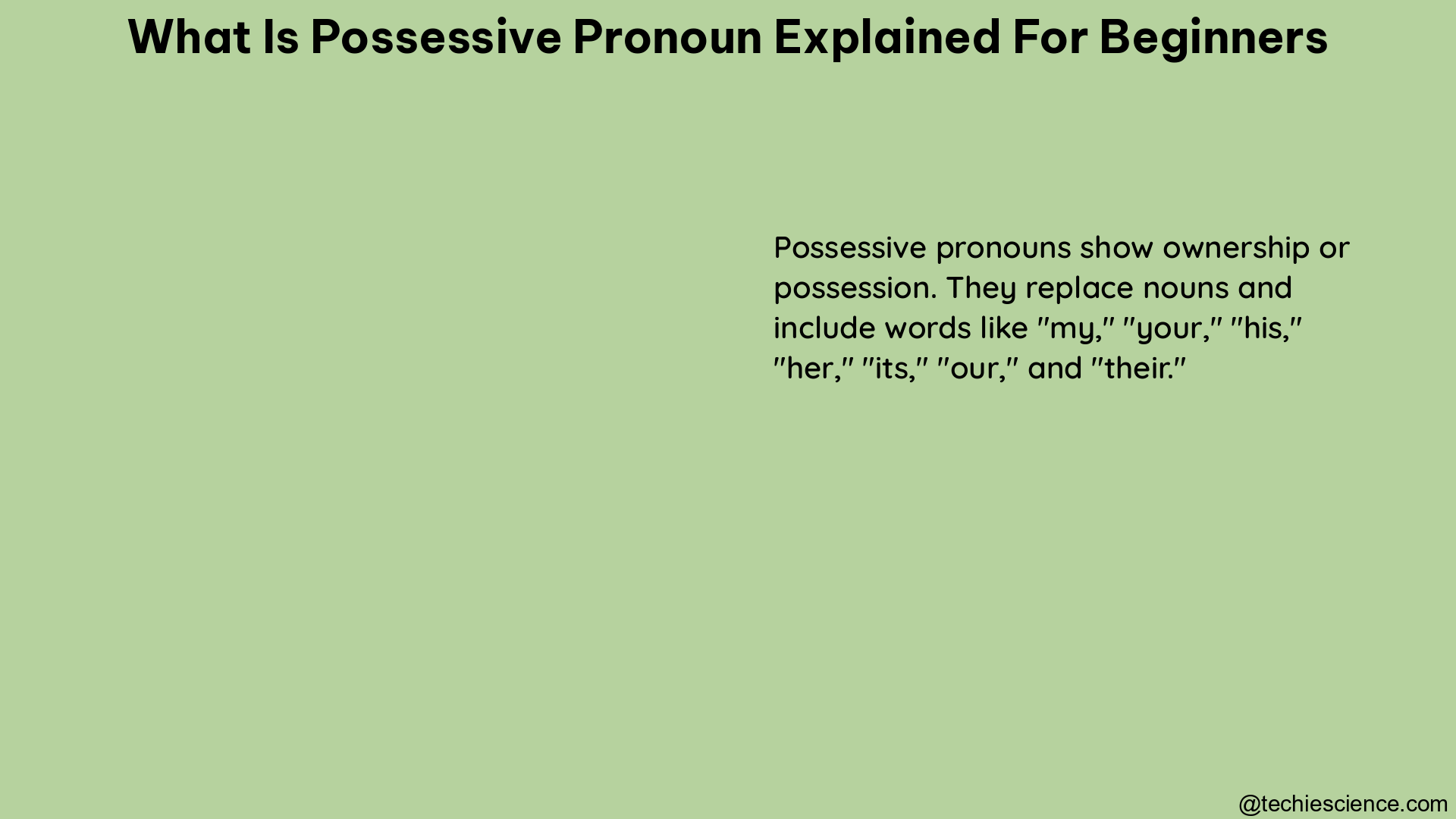A possessive pronoun is a type of pronoun that indicates ownership or possession of something. It is used to show that something belongs to a particular person, animal, or object. Possessive pronouns are essential in English grammar as they help to clarify who owns or possesses something.
Definition and Examples
Possessive pronouns are words that replace nouns to indicate ownership. They are used to answer the question “Who does something belong to?” For example:
- Mine (belonging to me)
- Yours (belonging to you)
- His (belonging to him)
- Hers (belonging to her)
- Its (belonging to it)
- Ours (belonging to us)
- Theirs (belonging to them)
These pronouns are used in sentences to show possession:
- “This book is mine.” (The book belongs to me.)
- “That car is hers.” (The car belongs to her.)
- “The dog is playing with its toy.” (The toy belongs to the dog.)
Key Points to Remember

- Placement: Possessive pronouns go after the noun or in place of the noun.
- Usage: They are used to show ownership or possession.
- Examples: Mine, yours, his, hers, its, ours, theirs.
Comparison with Possessive Adjectives
Possessive pronouns are often confused with possessive adjectives. The key difference is that possessive adjectives go before the noun, while possessive pronouns go after the noun or replace the noun:
- Possessive Adjective: “This is my car.” (The adjective “my” goes before the noun “car.”)
- Possessive Pronoun: “This car is mine.” (The pronoun “mine” replaces the noun “my car.”)
Advanced Usage
Possessive pronouns can also be used to express origin or a special relationship:
- Origin: “Chicago is Will’s home and Atlanta is ours.” (Ours indicates that we originate from Atlanta.)
- Relationship: “I brought my younger sister to the party and Mila brought hers, too.” (Hers indicates a relationship between Mila and her sister.)
Practice Exercises
- Marianne liked my cookies more than your cookies.
- Answer: Marianne liked my cookies more than yours.
- Sherlock, is that your car?
- Answer: Sherlock, is that yours?
- Did you find the cat’s bell?
- Answer: Did you find its bell?
Grammatical Specifics
Possessive Pronouns and Possessive Adjectives
Possessive pronouns and possessive adjectives are both used to indicate ownership or possession, but they have distinct grammatical functions.
Possessive adjectives are used to modify nouns, and they come before the noun they are describing. Examples of possessive adjectives include “my,” “your,” “his,” “her,” “its,” “our,” and “their.”
On the other hand, possessive pronouns stand alone and replace the noun they are referring to. They can be used independently without a noun. Examples of possessive pronouns include “mine,” “yours,” “his,” “hers,” “its,” “ours,” and “theirs.”
Here are some examples to illustrate the difference:
- Possessive Adjective: “This is my book.” (The adjective “my” modifies the noun “book.”)
- Possessive Pronoun: “This book is mine.” (The pronoun “mine” replaces the noun “my book.”)
Possessive Pronouns and Possessive Case
Possessive pronouns should not be confused with the possessive case, which is formed by adding an apostrophe and “s” to a noun to indicate ownership.
For example:
- Possessive Case: “That is John’s book.” (The apostrophe “s” indicates that the book belongs to John.)
- Possessive Pronoun: “That book is his.” (The pronoun “his” indicates that the book belongs to him.)
The possessive case is used to show ownership of a specific noun, while possessive pronouns are used to replace the noun and indicate ownership.
Possessive Pronouns and Reflexive Pronouns
Possessive pronouns should also be distinguished from reflexive pronouns, which are used to refer back to the subject of a sentence.
Examples of reflexive pronouns include “myself,” “yourself,” “himself,” “herself,” “itself,” “ourselves,” and “themselves.”
Here’s an example to illustrate the difference:
- Possessive Pronoun: “The book is mine.” (The pronoun “mine” indicates ownership of the book.)
- Reflexive Pronoun: “I bought the book myself.” (The pronoun “myself” refers back to the subject “I.”)
While both possessive and reflexive pronouns are types of pronouns, they serve different grammatical functions in a sentence.
Conclusion
Possessive pronouns are a crucial part of English grammar, helping to clarify ownership and possession. By understanding the definition, examples, and usage of possessive pronouns, you can improve your communication skills and express yourself more effectively.
References
- English with Billiebug. (2018). What Are Possessive Pronouns? | English Grammar Lessons. YouTube. https://www.youtube.com/watch?v=p_XwUtCeddo
- Thesaurus. (2021). What Is A Possessive Pronoun? Definition And Examples. https://www.thesaurus.com/e/grammar/possessive-pronouns/
- Twinkl. (n.d.). What is a Possessive Pronoun? | Definition & Examples. https://www.twinkl.hu/teaching-wiki/possessive-pronoun

The lambdageeks.com Core SME Team is a group of experienced subject matter experts from diverse scientific and technical fields including Physics, Chemistry, Technology,Electronics & Electrical Engineering, Automotive, Mechanical Engineering. Our team collaborates to create high-quality, well-researched articles on a wide range of science and technology topics for the lambdageeks.com website.
All Our Senior SME are having more than 7 Years of experience in the respective fields . They are either Working Industry Professionals or assocaited With different Universities. Refer Our Authors Page to get to know About our Core SMEs.